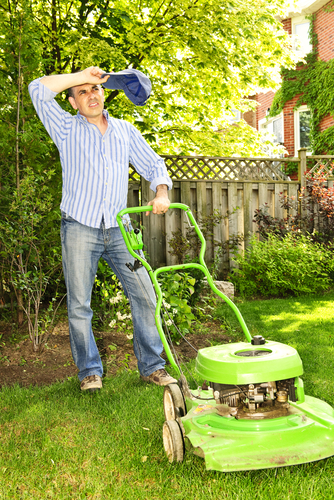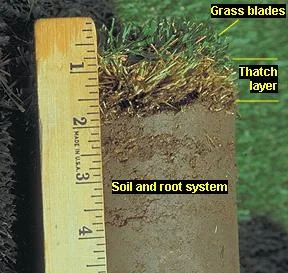Key Takeaways
Insights on lawn recovery:- Assessing Damage: Evaluate lawn roots to determine the extent of fertilizer damage.
- Watering Adequately: Flush out excess fertilizer by watering the lawn thoroughly.
- Root Inspection: Post-watering, check for new root growth to gauge recovery success.
- New Grass Planting: If necessary, prepare the ground for and plant new grass.
Are you getting a little carried away with your lawn fertilizer? We know fertilizer is an easy way of making sure your lawn is healthy and green, but if you start to apply a little too much, you can dry your soil out completely.
Over-fertilization will turn the grass yellow or brown, or even kill it completely! Over-fertilizing a lawn could cause a burnt appearance, and applying too much Nitrogen over the season can build an excessive thatch layer that could cause disease, prevent sunlight and stop the soil from receiving vital nutrients to share with the roots.
The good news is that an over-fertilized lawn can still be saved but you need to act as fast as possible. This article tells you what you need to do to fix that over-fertilized lawn whilst also advising on how to apply the right amount of nitrogen throughout the season, and get your grass back to that lush, green color you worked so hard to achieve.
What Caused My Over-Fertilized Lawn?
As you might have guessed, too much fertilizer can cause over-fertilization. However, there are a few other reasons your lawn might appear over-fertilized. If the soil does not drain properly, the salts in your fertilizer can build up and burn the roots, eventually killing them.
Pet urine can also cause areas of discolored grass since it has a high concentration of nitrogen. Stressed grass is prone to over-fertilization, especially if you have neglected your lawn for a while. The grass will struggle to absorb minerals and nutrients from the fertilizer, meaning it can accumulate too much salt.
Fertilizer burn is when excess minerals build up in the soil and no matter the cause, this can cause yellow or brown withered grass. Though not deadly, this can be difficult to recover and will depend on how much fertilizer is left in the soil, how moist the soil is, and how healthy the grass is. If your grass is only slightly yellow, it can be saved, whereas brown grass might prove trickier.
The main culprit, however, will be over-fertilizing a lawn and this can cause a "burn" or damage. Applying too much Nitrogen over the season can build an excessive thatch layer that could cause disease, prevent sunlight and stop any nutrients from getting to the roots.
A maximum of around 4 to 5 lbs of total Nitrogen is the recommendation to be put down on your lawn in one season. Therefore, if the bag says 25-3-10 that simply means 25% of that type of fertilizer is Nitrogen. If you end up putting 4 pounds of that certain fertilizer down per 1,000 square feet, this means you are putting down 1 lb of Nitrogen at the same time and you should put a maximum of 5 applications of that fertilizer down to achieve 5 lbs of Nitrogen throughout the season.
Fixing Your Over-Fertilized Lawn
1. Inspecting The Damage
Before you begin fixing the grass, you need to assess and inspect what damage you are dealing with. You should check the grassroots from different sections of the lawn and have a clear picture of how deep the problem is.
If the roots look healthy in most parts of the lawn, all you need to do is give your lawn enough water and the grass will grow back. However, if the roots seem dead and crunchy, you might want to consider replanting.
2. Removing The Fertilizer
If you have used granular fertilizer, you need to check to see if you have any left on the ground. Find a broom and attempt to sweep it away on any hard surfaces. You should not begin watering if you have not gotten rid of the spilled fertilizer beforehand. This will only add more salt to the soil.
3. Watering The Lawn
Watering the lawn helps to flush away all the excess salts from the grassroots. If you see the burned grass in time, watering will fix the problem quickly. However, you might be wondering how long you should apply the water to the grass. You should water until the soil struggles to soak anymore water in.
Don’t stick to just watering the over-fertilized areas. Make sure instead, you are applying water evenly on parts that appear healthy. This will help leach the salts across the yard.
You should make sure your lawn gets a decent amount of water on day one and then for the following 7 days. Make sure you are adding about an inch of water each day. Do this in the morning to minimize the risk of fungal diseases.
4. Inspecting The Roots
In a lot of cases, watering is the key to fixing an over-fertilized lawn. After around one to two weeks, you should see new growth if you have been watering daily. However, if nothing has changed, you need to inspect the roots.
Search for any new grassroots. If you find any, you have solved the problem. However, if you can’t, the damage is beyond repair and the only option you have left is to plant new grass.
5. Preparing The Ground For New Grass
If you need to plant new grass, you need to prepare the lawn first. Rake the burned, dead grass from the affected areas of the yard as this will give the water room to penetrate the healthy roots of the new grass. You then need to water the area for a week and wait at least a few days before planting.
This will help to get rid of the buildup of mineral salts living in the soil. Cleaning the soil is important as it allows the roots to establish themselves quicker and reach deeper into the soil.
6. Planting New Grass
Depending on the size of the lawn and affected areas, you can choose between laying new sod, or simply reseeding your lawn. If only a small area has been affected, you can fix this by reseeding. However, if you are dealing with much larger areas, you may find it easier to sod.
To get the best results from both methods, you need to make sure you are doing it right. If you are laying sod, be sure that the sod is pushed down enough, so the roots can hold the soil underneath. If you choose to reseed, cover the seeds with a thin layer of straw. This will keep critters and other elements away.
7. Maintaining Your New Grass
Whether you choose to re-sod or reseed, you need to care for the grass so that it can adapt to the new environment. Make sure you are sticking to a watering schedule. This needs to be done daily until the roots have been established, and then you can cut it back to two or three times a week.
You will also need to think about fertilizer once again, but avoid over-fertilizing this time. You need to apply it correctly and the baby grass will need starter fertilizer 2-3 weeks after planting.
Before mowing, wait for the grass to reach at least 3 inches. Trimming will make it grow quicker, but doing so before the grass reaches a proper height, may kill it. Moreover, if you let it grow too long and cut off too much at one time, this can cause further damage.
Final Thoughts
We hope by reading this article you have gained a better understanding of how your lawn might have become over-fertilized, as well as taken note of the steps on how to fix this. In a lot of cases, watering can be key to an easy solution, yet if the grass is beyond repair, it’s time to plant new grass.
For expert advice on lawn care, including fertilization and weed control, visit Cory’s Lawn Service today. Let us provide you with an evaluation on what is happening to your lawn and let us get your lawn back to looking healthy!








